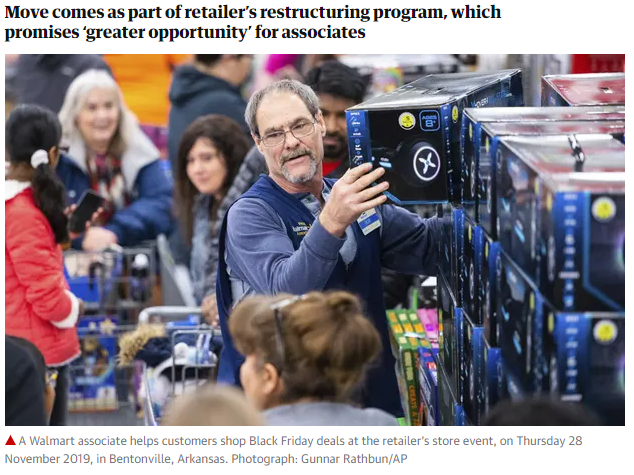Walmart is cutting some workers’ hours and pay while increasing their workloads, according to workers who spoke to the Guardian, all while promising “greater opportunity for associates to lead and take more ownership in the business”.
The retailer has emerged as one of the biggest winners of the pandemic. In August, Walmart announced a 9.3% rise in store sales and a 97% rise in e-commerce.
According to staff, the company is now pushing ahead with restructuring plans that for some workers has “cut hours horrendously. It made it very difficult to pay bills.”
Walmart began rolling out the plan – called the Great Workplace program in 2019 – but its introduction to several stores was delayed due to the coronavirus pandemic. The program restructured staffing by consolidating departments and roles, including layoffs for those not chosen for a new role.
Recently, Walmart released a restructuring program it said is similar to the Great Workplace program, touting the increased wages for those accepted into new management positions and pay raises in October for associates in some departments, although Walmart’s minimum wage of $11 an hour remains unchanged for front-end associates. Just 165,000 employees out of Walmart’s 1.5m workforce are expected to receive pay raises.
Several former and current Walmart said the Great Workplace program included significant cuts to workers’ hours, pay cuts, increased workloads, and Walmart’s new teaming program is expected to bring about similar changes.
“They combined three departments into one and then expected all the associates from those areas to fight for hours,” said Kimberly Patrick Gray, a Walmart associate for four years in Tupelo, Mississippi, who quit on 28 February 2020 after her schedule was reduced from around 35 hours a week on average to less than 20 hours this year. “The program just hurts the associates. It cut hours horrendously. It made it very difficult to pay bills.”
A department manager in Arizona, who requested to remain anonymous for fear of retaliation, expects to have their pay cut due to Walmart’s new restructuring by at least $2.05 an hour if they aren’t chosen for a team lead role, despite working over 20 years at Walmart.
“Those that are not offered a lead position or turn down a team lead over will have till 29 January to find another position,” they said. “Only those department managers that get team lead positions will receive a pay raise. The rest of us will be cut in pay. If I’m lucky I will only lose $2.05 an hour. It is possible that I could lose much more.”
Walmart said in its press release that associates in eliminated roles will maintain their current pay until October 2021, but it would not comment on what impact the changes will have on scheduled hours or workloads.
In Oklahoma, a customer service manager for three years at Walmart, said they will now be forced to reapply for a different position if they aren’t chosen for a team lead role. “My coworkers and I feel like we are being put against each other with this whole process because we feel like we are having to fight for these positions,” they said.
A cashier in California explained they’ve recently been given extra workloads, including being given tasks of restocking and front end inventory, which used to be handled by a manager.
“It’s more work for the same, or less money, unless you are one of the ones who roll into the new positions,” they said. “We are on a skeleton crew and there is zero time when there aren’t sales to ring.”
Eric Anderson worked part-time in grocery produce at a Walmart supercenter in Mulberry, Florida, which rolled out the new program early last year, before he quit in October 2019 due to changes caused by the program.
“The first inklings of trouble came when my produce manager, who had 20 years with Walmart, said he was going to have to re-apply for his job. Same with several more longtime employees,” Anderson said.
Leading up to the layoffs through Walmart’s Great Workplace program, Anderson said store departments were consolidated, while workloads increased and no new hires were made to replace workers who left.
“They all jumped through the hoops to reapply and none of them got to keep their jobs. Most were eligible for a severance for their years of service. At that point Walmart would not tell them when their last day would be, so they couldn’t apply for other jobs because they didn’t know when they could start,” he said. “When I saw how this company treated loyal long time employees, I decided I was done.”
Walmart is the largest private employer in the US. The company touted an increase of its minimum wage to $11 an hour and up to $1,000 in bonuses for its workers, totaling around $400m, in response to the passage of Donald Trump’s tax cut bill in December 2017.
Walmart is estimated to save around $2.2bn annually from the tax cut bill. Before the bill was passed, Walmart announced plans to spend $20bn over the next two years on stock buybacks. Ken Jacobs, the chair of the University of California at Berkeley Labor Center has estimated it would cost Walmart $3.8bn to increase their minimum wage to $15 an hour, the level being lobbied for by the Fight for $15 movement, Senator Bernie Sanders and others.
Shortly after Walmart announced the wage increases and bonuses, labor cuts began. In January 2018, Walmart announced the closure of 63 Sam’s Club locations in the US, resulting in around 10,000 layoffs. In early 2019, Walmart announced it would be eliminating greeter positions at about 1,000 of its retail locations. Later that year, Walmart shut down a corporate office in Charlotte, North Carolina, laying off 570 workers as the work was outsourced to a firm in Arkansas. The company’s recent Great Workplace program was expected to result in thousands of layoffs over the course of its rollout, and workers are concerned teaming will produce similar results, whether in terms of layoffs or workers leaving the company due to changes.
Gary Stevens worked as a maintenance supervisor at a Walmart in Ticonderoga, New York, for eight years before he quit on 23 February 2020 after the Great Workplace program rollout reduced his staff by nearly 50%.
“Work loads increased and the management was pushing us to get more done than if I had a full staff. Not one of them knew how to do my job in stripping and waxing floors, but they would tell me how long it should take and yell at me and my crew if we ran behind the time they gave us,” Stevens said.
A Walmart spokesperson declined to comment on complaints from workers about the program but told the Guardian: “Walmart is retooling how associates meet the needs of customers by building a more associate-empowered way of working. There will be greater opportunity for associates to lead and take more ownership in the business.”
The spokesperson deferred comment about the new team program to a press release on the new team-based operating model.
“We’re taking the next steps by introducing a team-based operating model in our Supercenters – similar to the one that has been very successful at Sam’s Club over the past year and in our Neighborhood Market stores this year. We’re investing in new roles and skills training to give us the flexibility to serve customers anytime and anywhere. In turn, associates will have more room for career and pay growth,” said Walmart’s COO, Dacona Smith.
Article Source: https://www.theguardian.com/business/2020/sep/24/walmart-workers-hours-pay-great-workplace







